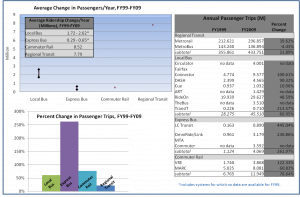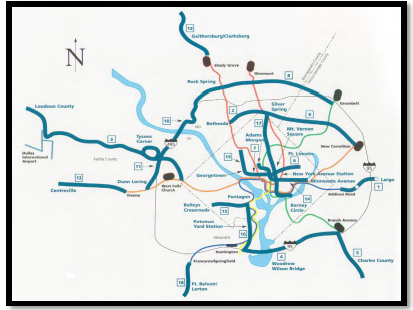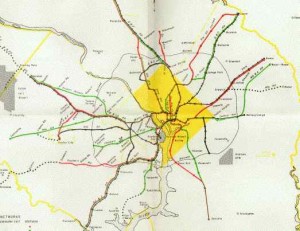The Regional Transit System Plan (RTSP) is intended to update the currently adopted Transit System Expansion Plan (TSEP) that was completed in 1999. In its implementation, the RTSP looks beyond the planning horizon of the TSEP by an additional fifteen years and incorporates updated travel demand, population and employment forecasts for the region. The following discussion will look at how much ridership growth has occurred over the ten-year period between 1999 and 2009, and will look at changes in the regional growth projections out to 2040 that will shape future demand for transit services.
Changes in Ridership

Figure 1. Change in ridership. Source: NTD
As envisioned in the adopted plan, transit ridership has grown since 1999, and is on the way toward the TSEP goal of doubling ridership by 2025. Annual transit passenger trips throughout the region have increased by about 30% in the first 10 years of the 25 year planning horizon. However, this growth in ridership has not been consistent across the region: close inspection of these data shows that ridership growth is happening at a faster rate on local feeder bus, express bus, and commuter rail services than for regional Metrorail and Metrobus services, although Metro accounts for the majority of the growth in absolute terms. The growth in ridership on local and commuter transit services highlights the need to create a transit plan that looks beyond the services provided only by Metro and to focus on the region at large.
Read more…
Will the regional transit system be up to the challenge of meeting the Transportation Planning Board (TPB) Vision’s objectives and the Greater Washington 2050 Coalition Region Forward’s targets, especially for a higher transit mode share in 2040?

Image from mwcog.org
In early 2010, the Metropolitan Washington Council of Governments endorsed Region Forward. It includes goals, objectives and targets for the metropolitan area in 2050, relating to accessibility, sustainability, prosperity and livability. Transportation is one of nine categories among its goals, and the transportation targets draw heavily from the TPB Vision that was adopted in 1998. The Regional Transit System Plan (RTSP) is intended to help develop strategies to achieve Region Forward’s goals, objectives and targets. Several of these targets are focused on transit, and are compatible with the goals of the RTSP. What follows is a listing of Region Forward’s transit-focused goals, and how a future including an implemented RTSP may help achieve them.
Priority for management, performance, maintenance, and safety
This target echoes an objective in the TPB Vision and is intended to insure that investment in existing transportation infrastructure continues as a top priority. For example, Virginia’s funding for roads follows this philosophy, by funding road maintenance and operations off the top of revenues. That philosophy would be advantageous for transit, too, so that investments in new infrastructure wouldn’t result in disinvestment in the existing bus and rail infrastructure that continues to be needed.
RTSP is evaluating an “Enhanced Surface Transit” strategy, in which the network of 24 Metrobus Priority Corridors (PCN’s) are enhanced with bus priority treatments, intended to increase performance of surface transit service in the region while reducing overall operating costs. The RTSP will also look into new surface transit connections with an eye towards interoperability, which would help reduce costs of managing and maintaining different new light rail and streetcar systems. Read more…
Metro’s Transit Service Expansion Plan (TSEP) of 1999 is comprised of four major elements that form the backbone of a regional transit system. This post is intended to highlight the status of projects implemented under the two elements of the plan that call for expansion of the region’s fixed-guideway transit system. The first involves selectively adding stations, entrances, and station capacity to the existing Metrorail system. Specifically, the plan calls for two new stations, four new station entrances, and expansion of station capacity at four existing stations. The second element of the Metro’s current plan that emphasizes system expansion focuses on the expansion of fixed-guideway systems – whether the mode is Metrorail, light-rail (LRT), other rail technology or busways.  The areas served by this element of the plan are illustrated on the map shown. Under this element, the goal is to provide for at least 50-percent expansion of the region’s fixed guideway systems over the 25-year planning horizon. Below are two tables that outline the status of the station and fixed-guideway projects in the plan.
The areas served by this element of the plan are illustrated on the map shown. Under this element, the goal is to provide for at least 50-percent expansion of the region’s fixed guideway systems over the 25-year planning horizon. Below are two tables that outline the status of the station and fixed-guideway projects in the plan.
How would you rate the implementation of the system expansion elements of the 1999 plan? Do you think the region is on-track to reach the goal to provide for at least 50-percent expansion of the region’s fixed guideway systems set in the 1999 plan? More importantly, do the projects that are yet to be completed represent the best ones to expand the region’s transit infrastructure over the next 15 or more years?
Read more…
In 1967, the Washington Metropolitan Area Transit Authority was created under a 1966 interstate compact encompassing the District of Columbia and portions of the State of Maryland and Commonwealth of Virginia, for the purpose of planning, financing, constructing, and operating a comprehensive mass transit system for the Washington Metropolitan Region. According to Article VI of the Compact the Board shall develop and adopt, and may from time to time review and revise, a mass transit plan for the immediate and long-range needs of the compact region.

An early plan of the Metrorail system, from the online exhibit, Building the Washington Metro.
The Compact guided the development of the original Adopted Regional System (ARS) in 1968, designed to serve the region as forecast for 1990. Zachary M. Schrag, author of The Great Society Subway, hosts a website including maps and photos of the ARS, as well as an historical account of the building of Metrorail. As planning and engineering continued over the next 20-plus years, the ARS was reviewed and revised, consistent with the Compact. By the mid-1990s, planning had been completed for the ARS. Metro began to look at transit needs beyond those for which the original system had been planned, and to look at a much larger region, as forecast for 2025. Metro’s latest long-range system plan — the Transit Service Expansion Plan— was adopted in 1999.
Read more…






Recent Comments